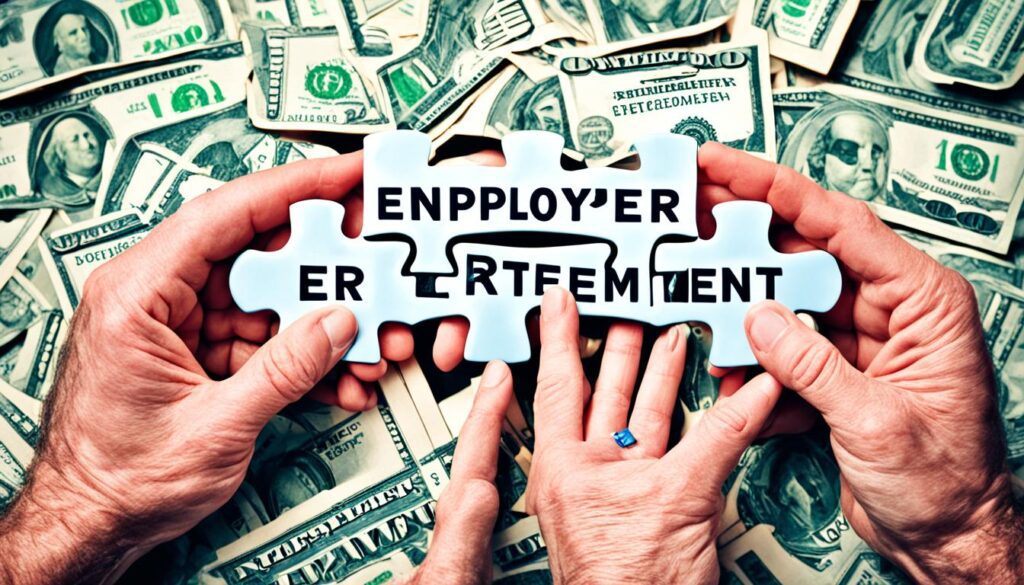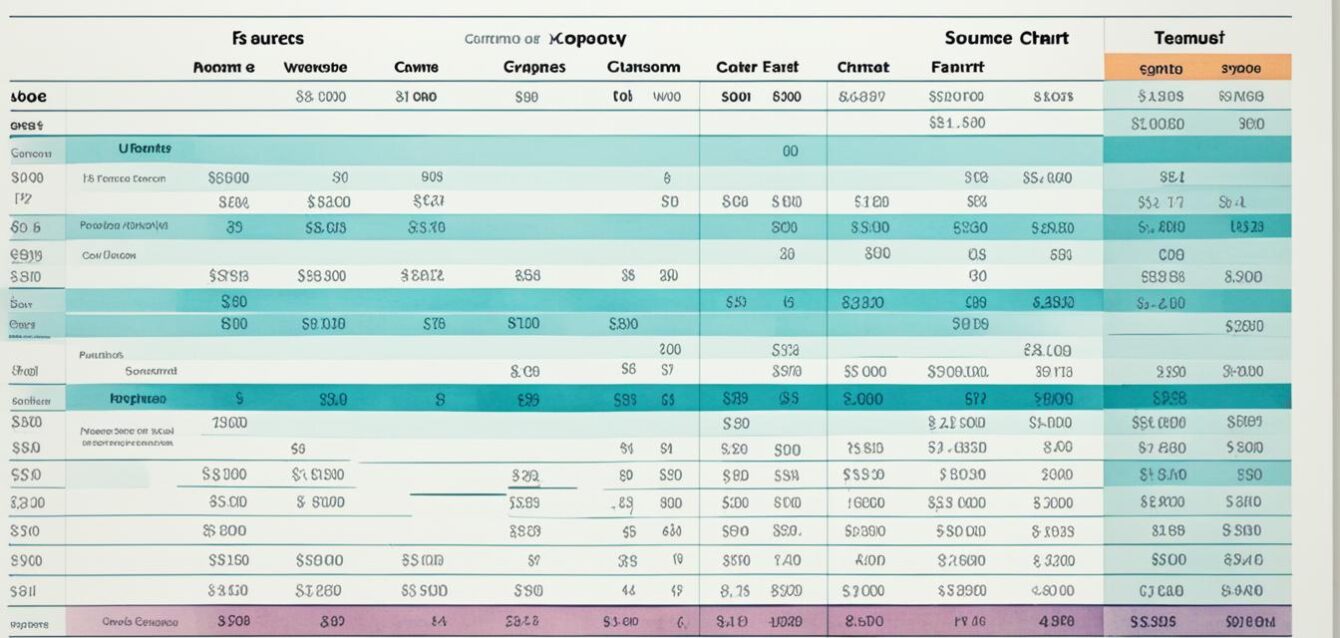Budgeting is key for anyone wanting to manage their money well. It means making a plan for spending and saving each month. The first step is knowing your net income, which is what you take home after taxes and other costs.
Tracking and sorting your expenses can show where you might spend less. Setting goals, both short and long-term, keeps you motivated to follow your budget. By planning how you’ll use your money, you can avoid spending too much.
Calculate Your Net Income
Calculating your net income is the first step in making a budget. It’s the money you have left after taxes and other deductions. If you get a regular paycheck, this is what you see in your bank account. But, remember to add back in any automatic deductions like retirement or health insurance to get a full picture of your money.
For those with irregular income, like freelancers or gig workers, it’s key to keep track of your work and payments. This helps you budget for irregular income and manage your money better.
Knowing your take-home pay lets you make a budget that meets your financial goals. Whether you’re figuring out your net income from a steady job or managing freelance or gig work income, this step is crucial for budgeting well.
Track Your Spending
Knowing your income is just the start of managing your money well. To really take charge of your finances, you must track your expenses and sort out your spending. Begin by noting down your fixed costs, like rent, utilities, and car payments. These are your steady, must-pay bills every month.
Then, list your variable expenses, which change often, like food, gas, and fun activities. To understand your spending habits better, look at your bank statements and credit card records. This helps you see and group your expenses. It also lets you spot where you might spend less.
It’s important to keep an eye on your spending regularly. You can use a budgeting app, a spreadsheet, or the classic envelope method. The main thing is to categorize your spending right after you buy something. This way, you’ll know exactly where your money goes. It helps you make smart choices about what’s important to you financially.
Set Realistic Financial Goals
Before you start budgeting, set some financial goals. These goals can be short-term, like saving for emergencies or paying off credit card debt. Or they can be long-term, like saving for retirement or your kid’s college. Having goals helps you stay motivated to follow your budget.
When thinking about short-term vs. long-term goals, be realistic. Start with a small emergency fund of $500 to $1,000. Then, aim to save 3-6 months’ worth of expenses. For long-term goals, try to save 15% of your income for retirement after you’re debt-free.
It’s important to prioritize your financial goals. First, pay off high-interest debt. Then, increase your savings. Use the 50/30/20 rule – 50% for necessities, 30% for fun, and 20% for savings and paying off debt. Also, make sure to use any employer retirement matching programs.
Your goals don’t have to be set forever. Keep reviewing and adjusting them to stay motivated and on track with your budgeting.
Make a Plan for Your Spending
Creating a detailed budget is crucial for reaching your financial goals. Begin by dividing your expenses into needs and wants. Needs include things like housing, transportation, and food. Wants are for things like eating out, movies, and hobbies.
Experts often suggest the 50/30/20 rule. This means spending 50% on needs, 30% on wants, and 20% on saving and paying off debt. This method helps balance your spending between must-haves and your financial goals, like saving for emergencies or paying off debt.
When planning your budget, focus on your needs first. This might mean cutting back on some wants. But, it’s a smart move for your financial health. By keeping track of your spending and sticking to your values, you can find budgeting strategies that fit you. This way, you can reach your financial goals.
Automate Your Savings
After making a budget and figuring out how much to save each month, the next step is to automate your savings. This means setting up automatic transfers from your checking to savings or investment accounts. Think about an emergency fund or retirement account. Automating your savings helps you save money before you can spend it, keeping you on track with your financial goals.
Many employers let you have part of your paycheck go straight into savings accounts. This makes it easy to build emergency fund and retirement accounts. By automating savings and setting up automatic transfers, saving becomes easier. Your money works for you, even when you’re not thinking about it.
Experts recommend starting with a $500 emergency fund for unexpected costs. They also suggest saving at least 15% of your income for retirement. By focusing on these goals and automating your savings, you move closer to a secure financial future.
Adjust Your Spending to Stay on Budget

Keeping a balanced budget is a continuous task. After setting your budget, you might need to make changes. Look at your “wants” like entertainment, dining out, and subscriptions. Can you cut back by choosing cheaper options or cutting some expenses?
If you’ve already cut back on discretionary spending, check your fixed expenses like insurance or monthly bills. Reviewing these costs might show ways to save, like finding better rates for auto or homeowner’s insurance. Making these budget adjustments can help you stay on track and save money without affecting your lifestyle too much.
Budgeting is not just for one time; it’s an ongoing process. By regularly reviewing your fixed expenses and finding ways to reduce discretionary spending, you can keep your budget effective. This helps you meet your financial goals.
How To Budget For Beginners
Budgeting might seem hard at first, but it’s easier than you think. Start small and build your skills in finance management and financial planning. This way, you can take control of your money.
First, figure out your net income. This is what you take home after taxes and other deductions. Use this as the base for your budget. Then, track where you spend your money to find ways to save more.
Set realistic financial goals for yourself, whether they’re for the short or long term. This keeps you motivated and focused. It’s important to have a plan for how you’ll spend your money.
Put your money into needs, wants, and money-saving tips like savings. Automating your savings helps you stick to your goals. Adjusting your budget regularly keeps you on track.
Small changes in spending can lead to big savings over time. Start budgeting and keep at it. With practice, you’ll reach your financial planning goals.
Review Your Budget Regularly

Budgeting is a continuous task. It’s key to review your budget regularly to keep on track. Make it a habit to check your budget at least once a month, or even more if needed. This helps you adjust your spending as your income or expenses change.
As you move towards your financial goals, you might need to revisit your budget. You might need to reallocate funds or change your priorities. Regularly reviewing your budget keeps you motivated and focused on your financial goals.
By monitoring your progress and updating your budget when necessary, you can manage your finances well. This approach helps you avoid unexpected financial issues. It also lets you reach your savings and debt-reduction goals more effectively.
The 50/30/20 Budget Rule
Budgeting can seem tough, but the 50/30/20 budget rule makes it simpler. It splits your net income into three parts: needs, wants, and savings allocation.
With the 50/30/20 budget rule, about 50% of your income goes to must-haves like rent, food, and transport. The next 30% is for wants, like fun activities and eating out. And, you should save 20% for savings and debt repayment to grow your savings and reach your goals.
This budgeting framework balances your spending. It makes sure you have enough for basics and still lets you enjoy life. It’s perfect for beginners who want a budget that fits their life and financial goals.
The 50/30/20 budget rule is just a starting point. You might need to change the percentages if you live in a pricey area or have special financial needs. The goal is to pick a budgeting method that suits you and helps you meet your savings allocation and financial targets.
Prioritize Your Financial Goals

When making your budget, it’s key to put your financial goals first. This helps you work on the most important ones right away. Start by building an emergency fund with 3-6 months’ worth of expenses. This fund can protect you from unexpected money problems without causing debt.
Then, aim to catch any employer retirement account match. This extra money can greatly increase your retirement savings. After these big goals, work on paying off high-interest debt, like credit cards, which can eat into your budget.
After getting these basics covered, focus on boosting retirement contributions, paying off low-interest debt, and growing your emergency fund. Remember, prioritizing financial goals is crucial for steady progress and financial stability.
Build an Emergency Fund
Building an emergency fund is key to your financial health. Experts say aim to save 3-6 months’ expenses in a savings account. This fund covers unexpected costs like medical bills or car repairs without debt. Starting with a smaller goal, like $500 or $1,000, can make it feel more achievable.
Adding to your emergency fund over time brings financial security and peace of mind. Regularly adding small amounts, like $5 or $100, helps build savings without hurting your budget. Setting up automatic savings helps your emergency fund grow steadily.
Don’t let the urge to spend more or get new credit cards distract you from saving. After reaching your goal, don’t over-save in a low-interest account. Consider moving your savings to higher-interest investments like retirement accounts for better returns.
Having an emergency fund is vital for your financial well-being. By setting realistic savings goals and sticking to them, you can shield yourself from the shock of unexpected expenses. This ensures your long-term financial security.
Capture Employer Retirement Match

If your employer offers a retirement account match, like a 401(k), make it a top priority. An employer retirement match is free money that can greatly increase your long-term tax-advantaged savings. Employers usually match a part of your 401(k) contributions, up to a certain limit. By putting in enough to get the full employer match, you’re getting an immediate return on your investment.
This free money, along with the tax benefits of a retirement account, can greatly help your maximize retirement savings.
Experts suggest putting 10% to 20% of your income towards retirement. But if your employer matches your contributions, aim to put in enough to get the full match. This is like getting free money that can speed up your retirement savings. Using an employer retirement match can greatly improve your financial future and help you retire comfortably.
Pay Off High-Interest Debt
Working towards financial freedom means tackling high-interest debt first. This includes credit card balances with APRs over 20%. By paying off these debts, you can use more of your income for saving and investing.
Getting rid of high-interest debt boosts your credit score and gives you a sense of freedom. 43% of U.S. adults with a credit card balance say it’s for emergencies or unexpected costs. Only 44% of Americans can cover an unexpected $1,000 expense from savings. Tackling your high-interest debt is a big step towards a secure financial future.
Try the debt avalanche method to pay off high-interest debts first. Look into balance transfer credit cards with 0% APR periods to save on interest. Side hustles, windfalls, or spending less can also help you pay off debt faster.
Eliminating high-interest debt is crucial for financial freedom. It helps you control your finances, improves your credit, and frees up resources for your goals.
Increase Retirement Savings
After you’ve saved for emergencies, grabbed any employer match, and cleared high-interest debt, it’s time to grow your retirement savings. Experts suggest saving 15% or more of your income for retirement, including employer contributions. This is key for a secure and comfortable retirement.
The magic of compound interest means early savings lead to more growth over time. By boosting your retirement savings in accounts like a 401(k), IRA, or other investments, you’re setting yourself up for a great retirement. This helps you meet your financial goals and enjoy your golden years.
About 25% of Americans have no retirement savings, and women earn about 30% less in retirement than men. This shows how vital it is to focus on your retirement savings and use compound interest to your advantage. Start with a small amount and increase it as you can. Automating your savings can also keep you on track easily.
Expand Your Emergency Fund
Building a solid emergency fund is key to financial stability and resilience. After saving 3-6 months’ worth of expenses, think about growing your fund more. Aim for 6-12 months’ worth of expenses for better security and to handle unexpected challenges like job loss or major medical emergencies.
Having a bigger emergency fund means you’re better protected. It lowers the chance of using high-interest debt or tapping into long-term savings for unexpected expenses. This financial safety net brings peace of mind and lets you handle life’s surprises without risking your financial health.
To increase your emergency fund, set up automatic savings by transferring money from your checking account. This method ensures steady savings and boosts your financial resilience over time. Always check your savings regularly and adjust your goals as needed to keep your emergency fund ready for your changing needs.
Pay Off Low-Interest Debt
After you’ve tackled your high-priority financial goals, like building an emergency fund and paying off high-interest debt, focus on low-interest debt. This includes student loans, mortgages, or other debts with low interest rates. Paying off these debts can make you feel financially free. It also lets you use your monthly payments for saving and investing.
Becoming debt-free, even with low-interest debt, is a big step in your financial journey. By focusing on low-interest debt, you can save more for the future. You can put more money into retirement accounts or invest in growth opportunities. This strategy boosts your financial strength and helps you reach your long-term goals.
It’s important to balance your efforts. Tackle high-interest debt first but keep working on low-interest ones too. This balanced approach helps you move towards financial freedom. It prepares you for a more secure financial future.




